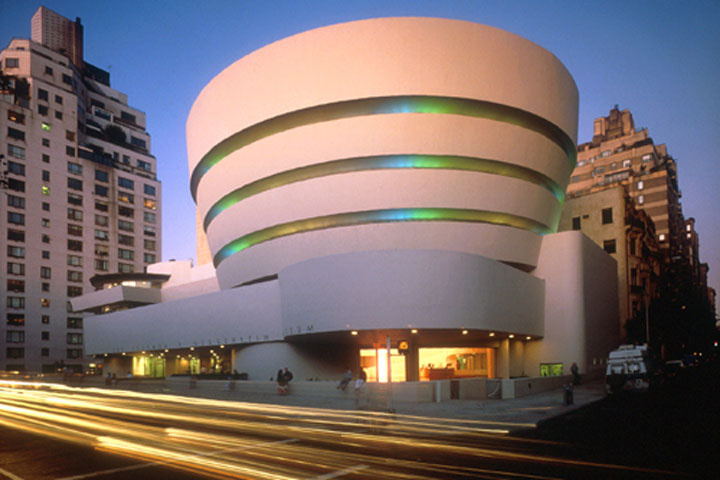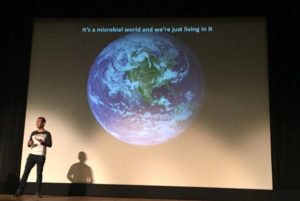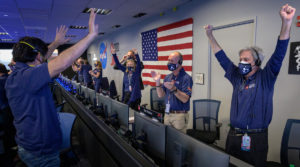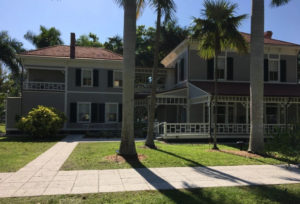(This is the second in a series of posts about hikes I’ve taken through New York City and elsewhere)
New York City. There is, in my opinion, no other city in the world that so easily reveals an eclectic mix of history, arts, entertainment, business/finance, retail, architecture, and simply people from literally every corner of the globe. All are slowly unveiled while walking the avenues, streets, bridges, and alleys of The Big Apple.
Over the last decade, I have embarked on many New York City hikes to experience the wonders of this great metropolis. I recently blogged on my walk through history via the Brooklyn and Manhattan bridges. This time, I turned north after my usual Amtrak ride from Albany.
Doing the Guggenheim:
I’ve been to far more baseball and football stadiums than museums, so the word Guggenheim is an unlikely utterance to escape my lips. But escape it did, as the target for an early spring 2008, walk. I had never been there yet word of the facility, its unusual design, and its regularly updated collections of impressionist, post impressionist, and contemporary art had somehow reached me. And it was in an area of Manhattan that I hadn’t explored.
Situated along the upper east side of a Fifth-Avenue stretch called Museum Mile, the Solomon R. Guggenheim Museum is easily one of the world’s most unusual-looking museums. Opened in 1959 and named for the famous businessman, art collector, and philanthropist, the Frank Lloyd Wright-designed museum soars about 100 feet above Fifth Avenue, just past the intersection with 88th Street. And because of its reverse spiraling upward design (sometimes referred to as an upside down wedding cake), it stands out starkly from the more common brick, concrete, cement, and metal structures that surround it. The building had a polarizing effect during design, construction, and after opening, but most architectural critics settled down and came to respect it for a design unduplicated elsewhere.

The Guggenheim Museum in New York City (credit: Guggenheim Museum)
Macy’s and Herald Square
It’s a sunny spring day when I emerge from the east side of Penn Station, beneath Madison Square Garden on Seventh Avenue between 31st and 33rd streets. Setting out north on Seventh, I pass a long line of appointment-bound travelers waiting at a cab stand. Pulling or carrying all manner of suitcases and other luggage, most are tapping their feet and inching forward anxiously toward the end of a double line of yellow cabs swooping in to discharge and pick up passengers. The ever-present honking from impatient drivers jars the mostly calm setting, intermittently disturbing the low hum and general din of passing traffic and literally thousands of conversations. Workers hawk newspapers and magazines from nearby newsstands. The odor of coffee and bagels drifts from small refreshment carts.
Since I must work my way east two blocks to pick up Fifth Avenue northbound, I turn right and cross Seventh onto 34th Street. At this intersection sits Macy’s of Herald Square — the granddaddy of all Macy’s, home to Thanksgiving Day parades, famous movies, myriad items for sale, and some of the best window displays in the world. As I walk east on 34th, pedestrian traffic is heavy on a wide sidewalk, framed on the left by the Macy’s display windows and large, decorative awnings. On the right are small trees in large concrete planters. Pedestrians crowd both sides of the planters, often jogging into the busy street to navigate around slower clumps of walkers.
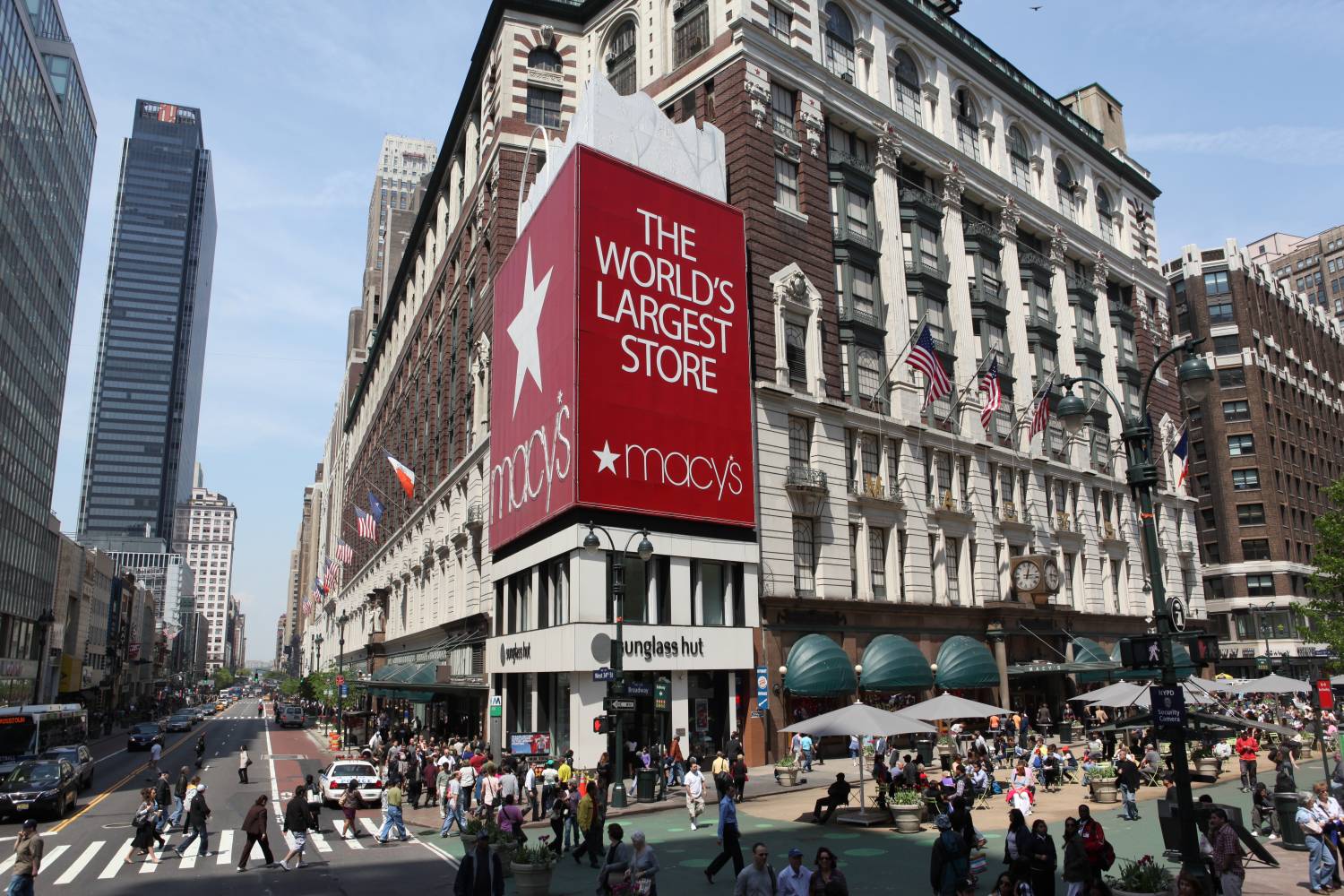
Macy’s of Herald Square (credit: Macy’s)
At Avenue of the Americas, also known as Sixth Avenue, sits one of the busier intersections in the entire city: Herald Square. Here, Broadway angles southeast to northwest across where 34th Street meets Sixth Avenue. The roads form a sort of crooked “X,” through which motor vehicles and pedestrians battle as traffic lights try to control the flow. It is not a situation for timid pedestrians or drivers. But because it is an extension of the retail mania that begins at Macy’s, cars and walkers slow to take in the scenery and electronic signs, further clogging the crossroads.
Just before Fifth Avenue on the right is the Empire State Building. Long since surpassed in the height department after opening its doors in 1931, it still stands out as one of the city’s most famous landmarks. It’s not that impressive at street level, but I can’t resist: I crane my neck upwards, almost falling backward in the process, to glimpse where the exasperated but fictional King Kong fought off small biplanes in the 1933 movie.
Fifth Avenue
I turn left on Fifth Avenue to head north. Here is where my “real” walk for the day begins. What lies ahead are 54 blocks or about five miles until I reach the Guggenheim at 88th. Traffic is one-way on Fifth, moving south toward Washington Square, opposite to my intended direction. The traffic is spread across six lanes, with one supposedly restricted to buses. On this pre-Uber day, it looks to me like more than half the traffic is comprised of yellow taxis, weaving back and forth across the lanes like a knot of furtive serpents. The taxis are in constant battle with large trucks, vans, private cars, and, pedestrians at each intersection. As traffic lights change at each junction, pedestrians charge forward like thoroughbreds fighting out of the starting gate.
I head north along Fifth. Even though it’s past morning rush hour, all lanes of the avenue remain congested, creeping along at 5 to 10 mph. The steady drone of traffic, bus, and truck diesel engines, and a low buzz of constant conversations and cell-phone chats is disturbed from time to time by honks and sirens. I plot a course slowly along the sidewalk on the left, occasionally bumping into walkers staring at their phones while I navigate through groups of tourists stopping to gaze and take pictures.
Fifth Avenue is known mostly as the world’s preeminent shopping Mecca. Some stores even carry the avenue name in their brand. Posh, high-end clothes retailer Saks Fifth Avenue is one of the most renowned. Salvatore Ferragamo, Gucci, Louis Vitton, Bergdoff Goodman, and many others appear on both sides. Heading north, I see retail businesses blending in with office buildings, coffee shops, restaurants, and historic landmarks such as the famous New York Public Library, which lords over the west side of Fifth at 42nd Street. The steps leading up to the century-old, marble structure are guarded by the oft-photographed statues of resting lions. Hundreds of visitors saunter up and down the steps.
Eight blocks north, Rockefeller Center appears on my left. It’s one of the top attractions in mid-town Manhattan. The 19-building, 22-acre complex is headquarters to businesses such as Comcast, formerly GE-NBC. I stop and stare at the blend of art-deco structures and more modern office buildings and skyscrapers. The bronze statue of Atlas is a favorite of amateur photographers, and today is no exception.

Rockefeller Center (credit: Rockefeller Center)
Across the street on the east side of Fifth is the majestic St. Patrick’s Cathedral. Completed in 1879, it was once one of the most physically prominent structures in the city. Today, even with its two soaring spires, the neo-gothic house of worship is dwarfed by business and commercial buildings that have grown up around it. Even though it looks out of place, St. Patrick’s remains one of the city’s most impressive architectural achievements. As I continue north on Fifth, the sharp light from the rising sun occasionally breaks through some of the skyscrapers to frame the upper reaches of the church.

St. Patrick’s Cathedral (credit: St. Patrick’s)
Proceeding farther north, I begin to lose track of the numerous landmarks on each side of the avenue, so I just amble and allow the scene to unfold. Passing 58th Street, I spot the glass-walled Apple store across the street on the right. The squat box structure serves primarily as an entrance to the sprawling Apple store below street level. Shoppers pour in and out of the entrance like ants scurrying to and from an anthill under construction.
Directly across the street from Apple are the leafy courtyard and fountains that frame the front entrance of the venerable Plaza Hotel. Featured often in movies and magazines, the grand dame of New York City hotels remains one of the best — and most expensive — places to eat and sleep. And its views of this part of the city are without peer.
Central Park
Once I cross 59th Street, the character of Fifth changes in a flash. Within a few hundred feet, the skyscrapers start to disappear. On the east side of Fifth, they are replaced with mostly lower, older buildings. Many are offices but others are beautiful, brick-faced residential complexes. On the west side of Fifth, the buildings disappear altogether. They are replaced by the trees and green, open space of one of the world’s largest urban recreational areas: the 843-acre Central Park. From 59th, this unusual park stretches north for more than 50 blocks before ending at 110th Street. This green border of Fifth Avenue’s west side is interrupted only by the Metropolitan Museum of Art between 80th and 84th streets, part of a collection of nine well-known museums known as Museum Mile.

Central Park (credit: Omni Hotels)
With over 20 blocks traveled, I pause to soak in the sudden change of scenery near the southern end of Central Park. The sidewalk here is a wide promenade made up of bricks and blocks instead of cement or asphalt. The walkway is broken up only by small patches of dirt from which trees sprout. There’s ample shade from the trees, so I sit for a while on one of the benches along the three-foot-high stone wall that forms the border between Fifth and the park. Despite heavy traffic, it’s much quieter here and I nod off for a few minutes. A prolonged honk from an impatient food delivery truck startles me awake and I continue the walk.
I find myself immersed in a wide variety of pedestrians, some dressed for work and hurrying, some wanderers searching for good park views, and even some parents or nannies pushing strollers or rushing with young kids in tow, dashing toward school or other appointments. The traffic clatter and density continue to decrease. I see many large, black SUVS with what appear to be professional drivers picking up and dropping off young families. Across the street more low-rise, older-style buildings house libraries, art collections, small office groups, doctors’ offices, and upscale homes or apartments.
Approaching 77th Street, I spot my first evidence of east-west cross street traffic on Fifth. This passageway allows a steady stream of traffic to enter the relatively quiet, nurturing green scenery of Central Park and cross to the west side of the city. For the first time since mid-town Manhattan, I have to wait for the traffic lights to cross, but I welcome the break. I take a few sips from a bottle of spring water I packed but thought I wouldn’t need. It’s a lot warmer now.
Approaching 88th a few minutes later, it’s hard to miss the buzz surrounding the Metropolitan Museum of Art, otherwise known as “The Met.” This historic museum sits on the west side of Fifth, and protrudes into Central Park. I’ve never seen it in person and I stop for 15 minutes to gaze at the massive entrance, framed by four sets of tall columns. Hundreds walk up and down one the widest set of entrance stairs I’ve ever seen. The stairways rival those of the Lincoln Memorial in Washington, D.C. Hot dog and other food/drink vendors line the sidewalk and plaza in front of the off-white and tan structure that stretches out from the main building on both sides, the result of additions over the years. Today it’s home to some 2 million objects. They range from ancient Egyptian artifacts to some of the world’s most famous, rare paintings.

The Met (credit: NYC Arts)
Arriving at the Guggenheim
A few blocks later, I finally spot my target. The light tan spirals of The Guggenheim emerge to my right. The unique building is ensconced between two taller, office/residential buildings just north and south.
Hundreds of visitors are milling about the entrance. Many are looking at brochures as they plan their tour. I sit outside to rest for a few minutes, before entering and buying my ticket. There’s a lot to absorb and I have since forgotten most of it. What I do recall is the primary display I saw that day. A series of exhibits along the long, circular walkway (1,416 feet long) to the top of the building featured work by Chinese-born artist Cai Guo-Qiang. He has spent part of his career studying gunpowder and explosions. Many of these blasts, or the results of detonations, are depicted in paintings, drawings, sculptures and other presentations. I had no idea he was the artist featured during my visit, but I find myself fascinated as I try to decipher what it all means.

Some of Quo-Qiang’s art (credit: the artist)
In the end, as I walk back down to street level, I admit I don’t understand much of Guo-Qiang’s art, but I achieved what I set out to: I enjoyed a great walk and exposed myself to some fresh thinking based on artwork I had never seen before. I finally exit the museum around 3 p.m. My head is swirling with images of destroyed buildings, shrapnel tracks, and victims as I start the hike back south to catch a late-afternoon train home.
With a little time to spare, I stop at a posh bar along Fifth below Central Park, and order a glass of pinot noir recommended by the pleasant bartender. It’s one of the best glasses of red wine I’ve ever had. I order a second. My period of quiet reflection on the day is shattered when I pay the tab. Each glass was $25. Well, I think to myself, I’m in Manhattan … but perhaps on future missions I’ll ask for a price first.
Penn Station is swarming with home-bound commuters when I arrive for my Amtrak north. I fight my way through thickets of briefcase- and pocketbook-toting office workers rushing to catch commuter trains to New Jersey or Long Island. I sigh with relief when I leave the crowds behind for a quiet seat on the train.
Another great day walking New York City is in the books. My train starts chugging slowly north. Within minutes I’m asleep, my senses dulled by the rocking train and the expensive wine.

